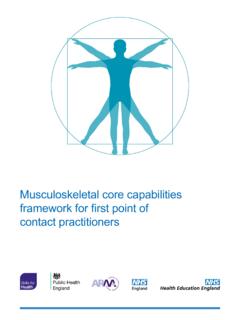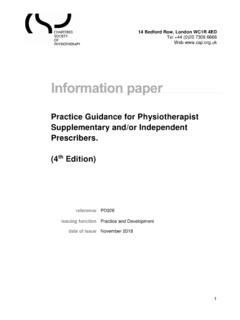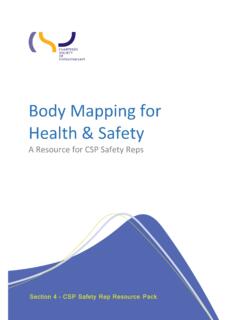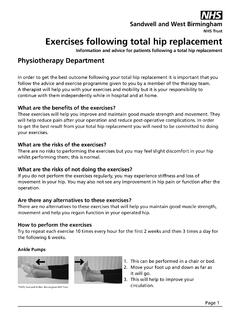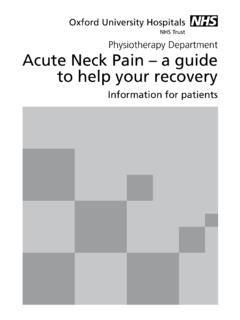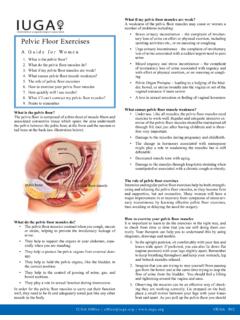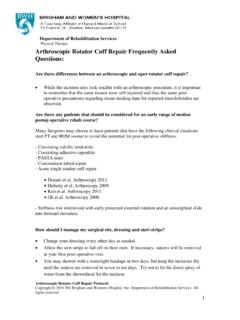Transcription of Stroke - Chartered Society of Physiotherapy
1 Stroke ?! Physiotherapy works 2nd edition October 2018 StrokePhysiotherapy enables people to relearn lost abilities, regain independence and reduce the risk of further improves recovery of function and mobility after Stroke (1). NICE recommends a minimum of 45 minutes of Physiotherapy five days a week as part of a seven day specialist Stroke rehabilitation service(2, 3). High intensity therapy is needed to relearn lost abilities(4). Rehabilitation should continue for as long as the person is showing measurable benefit from treatment and has achieved their agreed goals(2, 3). Access to community rehabilitation services should be flexible to support longer term Society OF Physiotherapy Stroke 2 Early Physiotherapy helps people relearn vital abilities From 24 hours after a Stroke , physiotherapists begin rehabilitation in short frequent spells, focused on getting out of bed, standing and walking(2, 6, 7).
2 This repetitive task training helps people regain movement and relearn everyday activities(8). Physiotherapists use assistive equipment to enhance Stroke rehabilitation. Robot-assisted devices support people to walk independently while treadmill training improves walking speed and endurance(9, 10). Virtual reality training may be beneficial alongside usual care but should not replace conventional therapy approaches(11).Early Support Discharge (ESD) Physiotherapy delivered by seven day services in ESD teams enables people to regain independence and reduces their length of stay in hospital (2, 3, 15). Longer term rehabilitation and reducing the risk of further strokes Community Physiotherapy teams support Stroke survivors to achieve longer term rehabilitation goals including reintegration back into the local community and return to work.
3 Most people who have a Stroke already have other long term conditions(16). This makes long term management complex. Flexible pathways which include easy access back into Physiotherapy are required to help people manage all aspects of their long term conditions(17). Physiotherapy teams help Stroke survivors incorporate the physical activity recommendations into their daily routine to reduce the risk of another Stroke by up to 35%(18). Physiotherapists can provide circuit training, involving intensive repetition of everyday activities, to help people walk further, faster, with more independence and confidence(19). Integrating endurance and strength training into rehabilitation reduces disability(20). Core stability and exercises incorporating balance, weight-shifting and gait improve balance after Stroke (21, 22).
4 ESD for people who are able to transfer independently or with a carer: Saves the NHS approximately 1600 over five years per extra patient receiving ESD(12) Reduces hospital length of stay by five days(13) Reduces long term dependency(13) Reduces admission to institutional care(13) Improves service satisfaction(14) Improves mental health scores of carers(14).FactCurrently 20% of Stroke survivors do not receive the recommended amount of Physiotherapy (26), two thirds leave hospital with a disability and 45% feel abandoned after leaving hospital(5). Chartered Society OF Physiotherapy Stroke 3 People of working age are two to three times more likely to be unemployed eight years after their Stroke (5). Around one in four strokes occur in people of working age, however people of working age are two to three times more likely to be unemployed after their Stroke and commissioning of vocational rehabilitation services is variable(5, 15).
5 Patient reported barriers include difficulty accessing rehabilitation services and limited capacity of rehabilitation teams to support people to return to work(23). On the last day of March I suffered a Stroke , this left me speechless and paralysed on my right side. Surviving a Stroke is the easy bit. Adjusting to the many changes it can bring is where the hard work begins . The Physiotherapy sessions were intensive and as hard as they needed to be. During my first session I called out I want Walk . I surprised myself by blurting out my demands but ever accommodating they had me on my feet within a short period of time. I left the unit walking on my own with a walking stick . I know it s a long road ahead but with the start I ve been given by the rehab unit, their encouragement along the way, I aim to achieve my goals.
6 Courtesy of Holywell Neurological Rehabilitation Unit, Hertfordshire Community NHS Trust. ?!Size of the problem and cost of ill healthIn the UK: Every year more than 100,000 people have a Stroke ; or one person has a Stroke every five minutes(5) The average cost of Stroke to the NHS per patient is 13,500 in the first year and 18,000 over 5 years(12) By 2035 rate of first time strokes will have increased by 59% and the number of Stroke survivors will rise by 123%(5) One in four Stroke survivors will experience another Stroke within five years(5). Patient Story-Terence GoodeThe Physiotherapy offer: what does good look like? Coordinated care in specialist inpatient unitsContinuity of care in ESD or community Stroke servicesCommunity Physiotherapy to enable physical activityThe same level of care as the top 5 CCGs in EnglandMore people alive, independent and living at home one year after Stroke (24)Reduced length of stay in hospital and 1600 saved per extra patient receiving ESD(13, 25)Reduced risk of Stroke by up to 35%(18) 51 million and over 600 lives saved(15)ProvidingOutcome Chartered Society OF Physiotherapy Stroke 4 The Early Supported Discharge Team in Sherwood Forest Hospitals NHS Foundation Trust enables patients to receive early, specialist Stroke care within their home environment.
7 Coordinated rehabilitation is delivered by the multidisciplinary team with access to a consultant and psychology input. The team have knowledgeable rehabilitation support workers trained in all disciplines to ensure that patients receive intensive well as providing monthly data to the Sentinel Stroke National Audit Programme, the team are the first in the East Midlands to provide additional data fields. This allows the team to promptly analyse changes in patients ability to perform everyday activities, the achievement of rehabilitation goals and the completion of mood and cognitive screening. This data is discussed routinely in multidisciplinary meetings and is also shared at divisional meetings to allow immediate learning and inform service Forest Hospitals ESD TeamAfter noticing inconsistency in outcome measure scores between leaving inpatient care and starting with ESD, meaning patients appeared to have deteriorated, both teams worked together to improve this.
8 Teaching sessions and guidance were developed to assist decision making and scoring consistency as well as regular communication between teams. Outcome measures are routinely compared, allowing real time examples and feedback which staff can learn from. The teams regularly review the data to evaluate the impact of changes made and adapt accordingly. Together they have: Reduced variation in outcome measure scores by 22% Improved transition of care and collaboration between inpatient and ESD services. Service Innovation ExampleCHARTERED Society OF Physiotherapy Stroke 5 ww-wwwww001555 SPED 10/2018 MOB1. Pollock A, Baer G, Campbell P, et al. Physical rehabilitation approaches for the recovery of function and mobility following Stroke .
9 Cochrane Database of Systematic Reviews. 2014(4) URL: 2. Intercollegiate Stroke Working Party. National clinical guideline for Stroke . 5th Edition. London: Royal College of Physicians 2016. URL: 3. National Institute for Health and Care Excellence. Stroke rehabilitation in adults. CG162. London National Institute for Health and Care Excel-lence; 2013. URL: 4. Veerbeek JM, van Wegen E, van Peppen R, et al. What is the evidence for Physical Therapy PostStroke? A systematic Review and Meta-Analy-sis. PLoS ONE. 201; 9(2):e87987. URL: 5. Stroke Association. State of the Nation: Stroke Statistics February 2018. London Stroke Association; 2018. URL: 6. Langhorne P, Wu O, Rodgers H, et al. A Very Early Rehabilitation Trial after Stroke (AVERT): a Phase III, multicentre, randomised controlled trial.
10 Health Technology Assessment (Winchester, England). 2017;21(54):1-120. URL: Bernhardt J, Thuy MNT, Collier JM, et al. Very early versus delayed mobilisation after Stroke . Cochrane Database of Systematic Reviews. 2009(1) URL: French B, Thomas LH, Coupe J, et al. Repetitive task training for improving functional ability after Stroke . The Cochrane Database Of Systematic Reviews. 2016;11:CD006073. URL: 9. Mehrholz J, Thomas S, Werner C, et al. Electromechanical-assisted training for walking after Stroke . Cochrane Database of Systematic Reviews. 2017(5) URL: Mehrholz J, Thomas S, Elsner B. Treadmill training and body weight support for walking after Stroke . Cochrane Database of Systematic Reviews. 2017(8) URL: Laver KE, Lange B, George S, et al.






